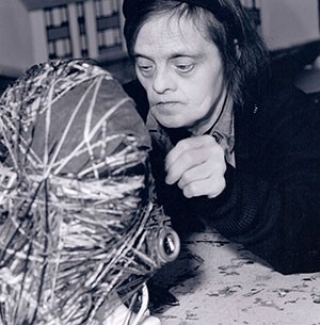Born 1943, Cincinnati, Ohio
Died 2005, Dutch Flat, California
During the eighteen years that Judith Scott made objects, her artistic idiom remained constant: totem- and cocoonlike sculptures of layered fibers, fabrics, and other materials deftly woven over an armature of quotidian items. Her sculptures range from relatively spare—a monochromatic ovoid of intricately coiled string punctuated by purple industrial tubing—to more exuberant forms composed of colorfully printed fabric strips, knotted and fraying with tactile appeal. Sometimes the elements in the elaborately composed armatures are left visible—spools of yarn, wire hangers, clothing, foam padding, or a bicycle wheel are recognizable; often they are concealed beneath the textured surface. Over the years Scott evolved a subtle and varied range of techniques, from loosely tethered skeins, to concisely placed woven loops, to variegated combinations of layered and intertwined fibers. Occasionally, individually bound forms are swaddled together in multipart, relational, compositions. A sophisticated feeling for juxtapositions of color and material—bold dualities, distinct tonal schemes, and complex layering of monochrome palettes—became a hallmark of her work.
Fastidiously poring over one sculpture at a time for weeks or months until she achieved resolution, Scott never returned to edit or reconsider past pieces. She worked at a table, usually limiting her objects to a scale she could maneuver from a seated position (though a late piece that incorporated a shopping cart provides an inventive exception). In one early work she loosely bound industrially painted wooden stakes with yarn that was threaded with roughly shaped beads, some of which dangle loosely, giving the suggestion of a ceremonial staff. More commonly, though, her sculptures appear sedentary, liminal perhaps, and pregnant with energy.
Scott began creating three-dimensional works in 1987 after seeing a demonstration of textile-based processes like weaving and embroidery at Creative Growth Art Center in Oakland, California, as part of a workshop for disabled adults she had been attending regularly for more than a year. Before that time Scott—who had Down syndrome, was profoundly deaf, and did not speak or use sign language—had been institutionalized in Ohio for thirty-five years. After her twin sister brought her to the Bay Area, Scott worked prolifically for the rest of her life.
Lauren Schell Dickens
Morris, Catherine, and Matthew Higgs, eds. Judith Scott: Bound and Unbound. Brooklyn: Elizabeth A. Sackler Center for Feminist Art, Brooklyn Museum, with DelMonico Books-Prestel, 2014.
